Offshore Wind Speed Forecasting: The Correlation between Satellite-Observed Monthly Sea Surface Temperature and Wind Speed over the Seas around the Korean Peninsula
Abstract
:1. Introduction
2. Data
2.1. Sea Surface Temperature Data
2.2. Wind Speed Data
3. Method
3.1. Time Series Analysis
3.2. Statistical Model for Wind Speed Forecasting
3.3. Model Evaluation
4. Results and Discussion
4.1. Relationship between Monthly Sea Surface Temperature and Wind Speed
4.2. Construction of a Monthly Wind Speed Forecasting Model
4.3. Evaluation
5. Conclusions
Acknowledgments
Author Contributions
Conflicts of Interest
References
- Lund, H. Large-scale integration of wind power into different energy systems. Energy 2004, 30, 2402–2412. [Google Scholar] [CrossRef]
- Strbac, G.; Shakoor, A.; Black, M.; Pudjianto, D.; Bopp, T. Impact of wind generation on the operation and development of the UK electricity systems. Electr. Power Syst. Res. 2007, 77, 1214–1227. [Google Scholar] [CrossRef]
- The Korea Herald. Available online: http://www.koreaherald.com/view.php?ud=20170510000794 (accessed on 10 May 2017).
- Energy Efficiency & Renewable Energy. Available online: https://apps2.eere.energy.gov/wind/windexchange/filter_detail.asp?itemid=1456 (accessed on 19 January 2007).
- Resende, F.O.; Peças Lopes, J.A. Management and control systems for large scale integration of renewable energy sources into the electrical networks. In Proceedings of the EUROCON—International Conference on Computer as a Tool, Lisbon, Portugal, 27–29 April 2011. [Google Scholar] [CrossRef]
- Stoutenburg, E.D.; Jenkins, N.; Jacobson, M.Z. Variability and uncertainty of wind power in the California electric power system. Wind Energy 2014, 17, 1411–1424. [Google Scholar] [CrossRef]
- Krishnappa, H. Long-term minute-wise wind forecasting using time series modelling. Int. J. Serv. Sci. Technol. 2016, 9, 179–188. [Google Scholar] [CrossRef]
- Klaassen, G.; Miketa, A.; Larsen, K.; Sundqvist, T. The impact of R & D on innovation for wind energy in Denmark, Germany and the United Kingdom. Ecol. Econ. 2005, 54, 227–240. [Google Scholar] [CrossRef]
- Phuangpornpitak, N.; Prommee, W. A study of load demand forecasting model in electric power system operating and planning. GMSARN Int. J. 2016, 10, 19–24. [Google Scholar]
- Soman, S.S.; Zareipour, H.; Malik, O.; Mandal, P. A review of wind power and wind speed forecasting methods with different time horizons. In Proceedings of the North American Power Symposium, Arlington, TX, USA, 26–28 September 2010. [Google Scholar] [CrossRef]
- Singh, S.; Kumar, N. Wind power forecasting: A survey. Int. J. Eng. Res. Gen. Sci. 2016, 4, 802–806. [Google Scholar] [CrossRef]
- Fortuna, L.; Nunnari, G.; Nunnari, S. A new fine-grained classification strategy for solar daily radiation patterns. Pattern Recogn. Lett. 2016, 81, 110–117. [Google Scholar] [CrossRef]
- Markard, J.; Petersen, R. The offshore trend: Structural changes in the wind power sector. Energy Policy 2009, 37, 3545–3556. [Google Scholar] [CrossRef]
- Kim, H.-G.; Jang, M.-S.; Ko, S.-H. Long-term wind resource mapping of Korean west-south offshore for the 2.5 GW offshore wind power project. J. Environ. Sci. Int. 2013, 22, 1305–1316. [Google Scholar] [CrossRef]
- Ahn, D.; Shin, S.-C.; Kim, S.-Y.; Kharoufi, H.; Kim, H.-C. Comparative evaluation of different offshore wind turbine installation vessels for Korean west-south wind farm. Int. J. Nav. Arch. Ocean 2017, 9, 45–54. [Google Scholar] [CrossRef]
- Kritharas, P.P.; Watson, S.J. A comparison of long-term wind speed forecasting models. J. Sol. Energy 2010, 132, 041008-1–041008-8. [Google Scholar] [CrossRef]
- Azad, H.B.; Mekhilef, S.; Gounder, V. Long-term wind speed forecasting and general pattern recognition using neural networks. IEEE Trans. Sustain. Energy 2014, 5, 546–553. [Google Scholar] [CrossRef]
- Shukla, J. Seamless Prediction of Weather and Climate: A New Paradigm for Modeling and Prediction Research; Climate Test Bed Joint Seminar Series; NCEP: Camp Springs, MD, USA, 2009. [Google Scholar]
- HORISON: The EU Research & Innovation Magazine. Available online: https://horizon-magazine.eu/article/seasonal-wind-forecasts-could-help-shape-energy-prices_en.html (accessed on 17 August 2016).
- Hodge, B.-M.; Lew, D.; Milligan, M.; Holttinen, H.; Sillanpää, S.; Gómez-Lázaro, E.; Scharff, R.; Söder, L.; Larsén, X.G.; Giebel, G.; et al. Wind power forecasting error distributions: An international comparison. In Proceedings of the 11th Annual International Workshop on Large-Scale Integration of Wind Power into Power Systems as well as on Transmission Networks for Offshore Wind Power Plants Conference, Lisbon, Portugal, 13–15 November 2012. [Google Scholar]
- Oh, K.-Y.; Kim, J.-Y.; Lee, J.-S.; Ryu, K.-W. Wind resource assessment around Korean Peninsula for feasibility study on 100 MW class offshore wind farm. Renew. Energy 2012, 42, 217–226. [Google Scholar] [CrossRef]
- Kim, H.-G.; Hwang, H.-J.; Lee, S.-H.; Lee, H.-W. Evaluation of SAR wind retrieval algorithms in offshore areas of the Korean Peninsula. Renew. Energy 2014, 65, 161–168. [Google Scholar] [CrossRef]
- Kim, J.-Y.; Kim, D.-Y.; Oh, J.-H. Projected changes in wind speed over the Republic of Korea under A1B climate change scenario. Int. J. Climatol. 2014, 34, 1346–1356. [Google Scholar] [CrossRef]
- Shimada, S.; Ohsawa, T.; Kogaki, T.; Steinfeld, G.; Heinemann, D. Effects of sea surface temperature accuracy on offshore wind resource assessment using a mesoscale model. Wind Energy 2015, 18, 1839–1854. [Google Scholar] [CrossRef]
- Smith, T.M.; Reynolds, R.W.; Peterson, T.C.; Lawrimore, J. Improvements to NOAA’s historical merged land-ocean surface temperature analysis (1880–2006). J. Clim. 2007, 21, 2283–2296. [Google Scholar] [CrossRef]
- Iizuka, S. Simulations of wintertime precipitation in the vicinity of Japan: Sensitivity to fine-scale distributions of sea surface temperature. J. Geophys. Res. 2010, 115, D10107:1–D10107:17. [Google Scholar] [CrossRef]
- Kwak, M.-T.; Seo, G.-H.; Cho, Y.-K.; Kim, B.-G.; You, S.H.; Seo, J.-W. Long-term comparison of satellite and in situ sea surface temperatures around the Korean Peninsula. Ocean Sci. J. 2015, 50, 109–117. [Google Scholar] [CrossRef]
- Milliff, R.F.; Morzel, J.; Chelton, D.B.; Freilich, M.H. Wind stress curl and wind stress divergence biases from rain effects on QSCAT surface wind retrievals. J. Atmos. Ocean. Tech. 2004, 21, 1216–1231. [Google Scholar] [CrossRef]
- Atlas, R.; Hoffman, R.N.; Ardizzone, J.; Leidner, S.M.; Jusem, J.C.; Smith, D.K.; Gombos, D. A cross-calibrated, multiplatform ocean surface wind velocity product for meteorological and oceanographic applications. Bull. Am. Meteorol. Soc. 2011, 92, 157–174. [Google Scholar] [CrossRef]
- Hasagger, C.B.; Mouche, A.; Badger, M.; Bingöl, F.; Karagali, I.; Driesenaar, T.; Stoffelen, A.; Peña, A.; Longépé, N. Offshore wind climatology based on synergetic use of Envisat ASAR, ASCAT and QuikSCAT. Remote Sens. Environ. 2015, 156, 247–263. [Google Scholar] [CrossRef]
- Field, J.G.; Hempel, G.; Summerhayes, C.P. Oceans 2020: Science, Trends, and the Challenge of Sustainability; WHOI: Woods Hole, MA, USA, 2002; p. 365. [Google Scholar]
- Torrence, C.; Compo, G.P. A practical guide to wavelet analysis. Bull. Am. Meteorol. Soc. 1998, 79, 61–78. [Google Scholar] [CrossRef]
- Foroni, C.; Marcellino, M. A Survey of Economic Methods for Mixed Frequency Data. Available online: http://cadmus.eui.eu/bitstream/handle/1814/25844/ECO_2013_02.pdf (accessed on 11 July 2017).
- Oh, K.-Y.; Kim, J.-Y.; Lee, J.-K.; Ryu, M.-S.; Lee, J.-S. An assessment of wind energy potential at the demonstration offshore wind farm in Korea. Energy 2012, 46, 555–563. [Google Scholar] [CrossRef]
- Global Energy Assessment-Toward a Sustainable Future; Cambridge University Press: Cambridge, UK; New York, NY, USA, 2012; p. 93.
- Gunturu, U.B.; Schlosser, C.A. Characterization of wind power resource in the United States. Atmos. Chem. Phys. 2012, 12, 9687–9702. [Google Scholar] [CrossRef]
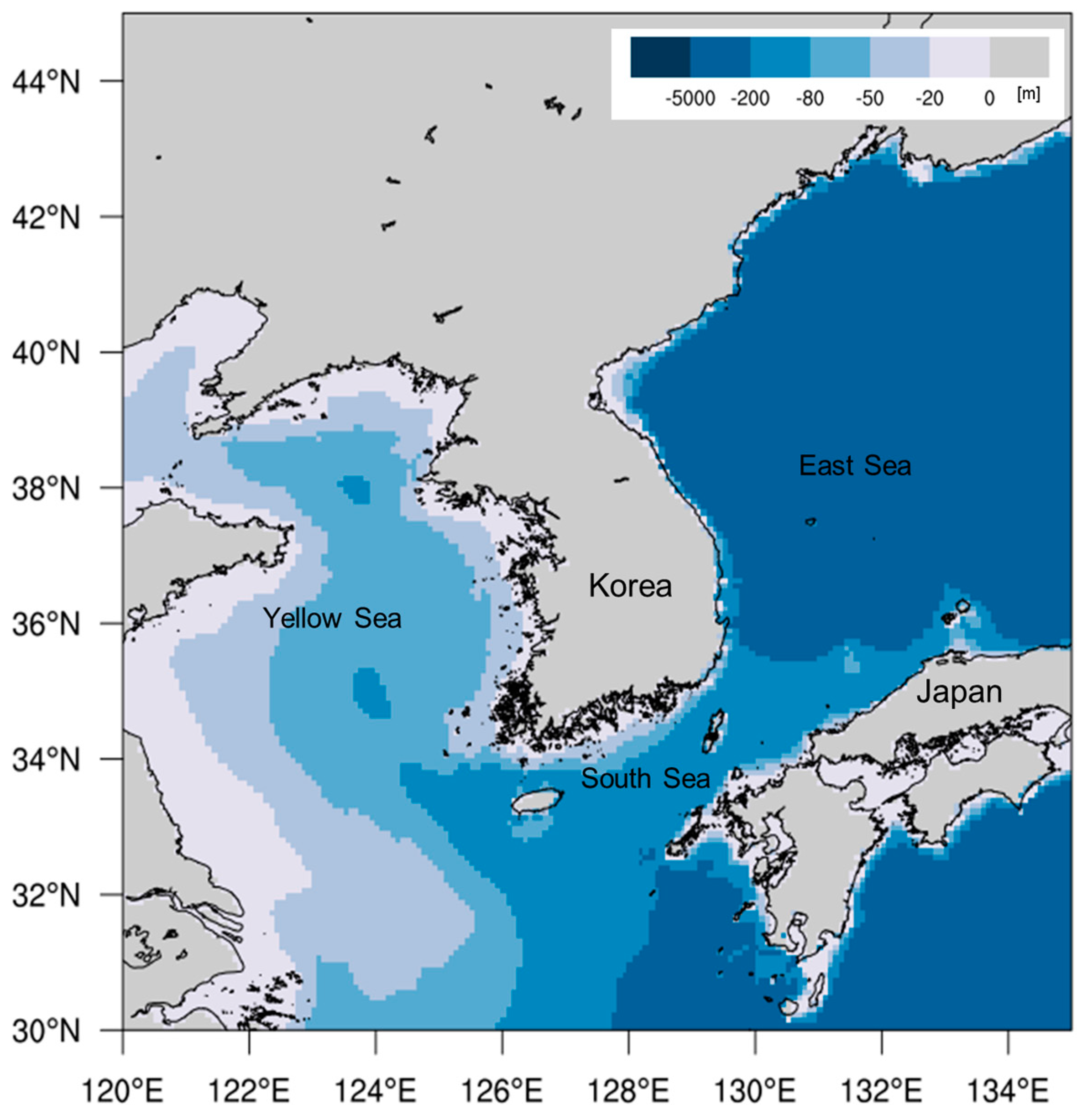
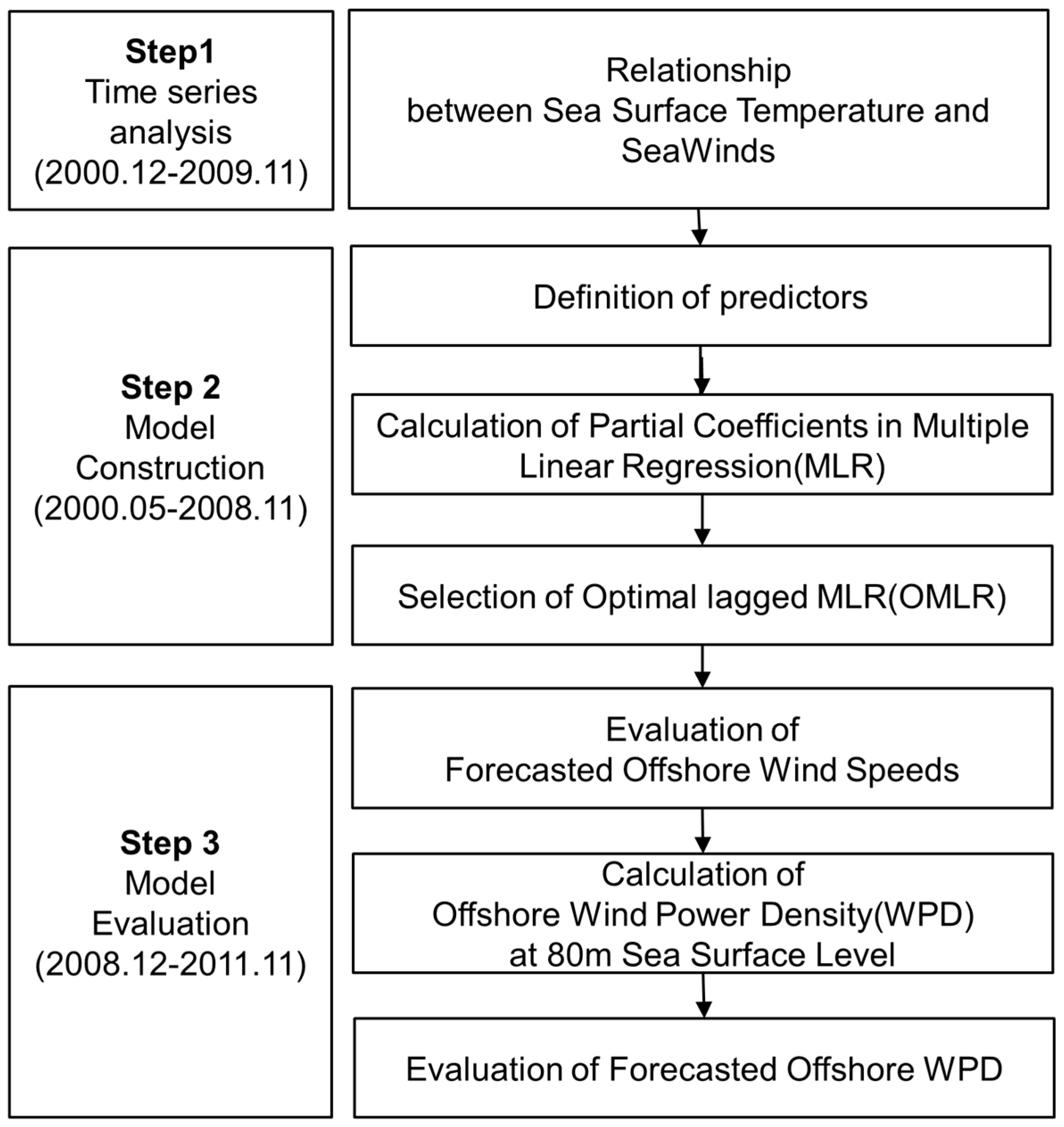
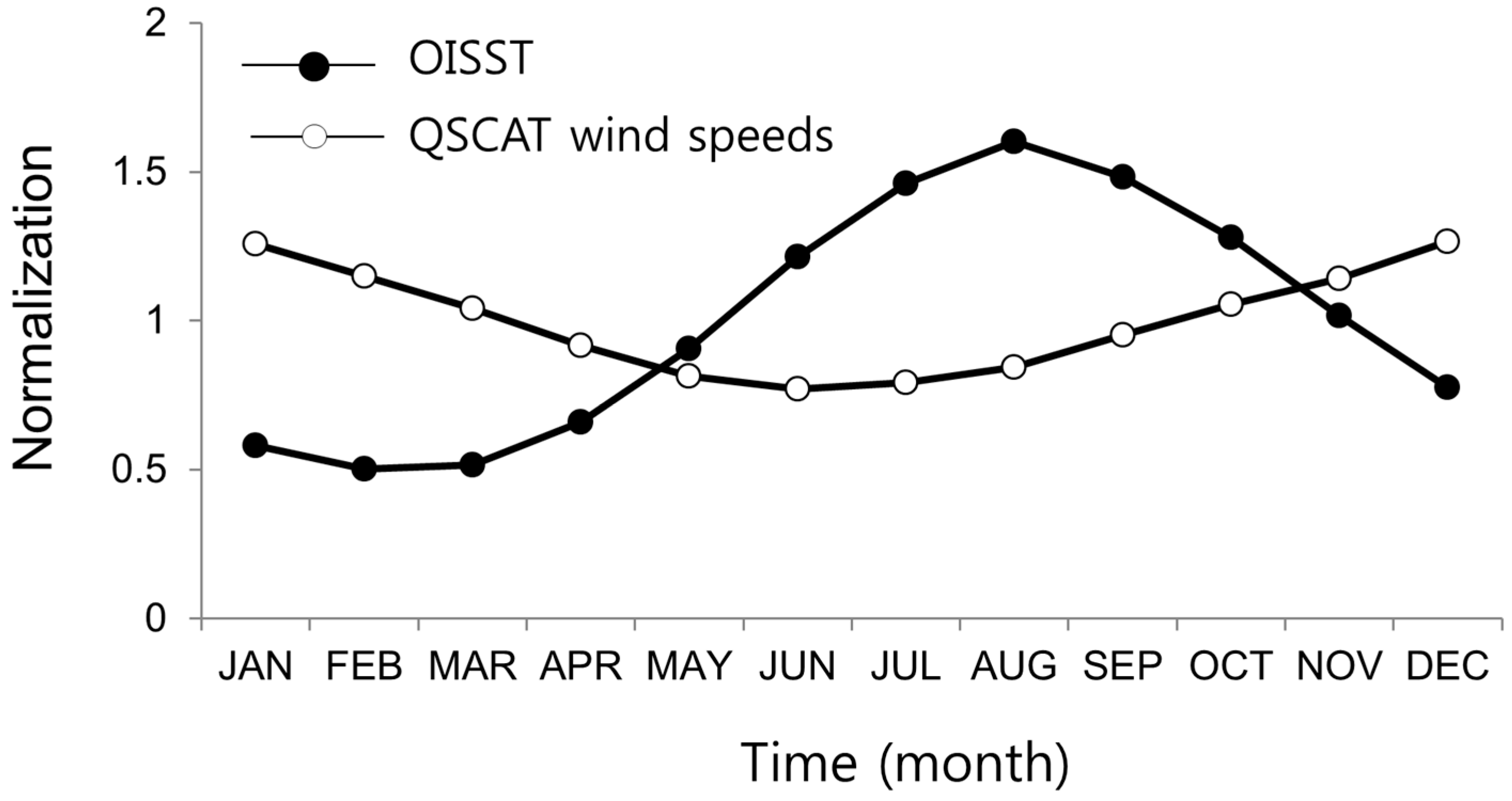

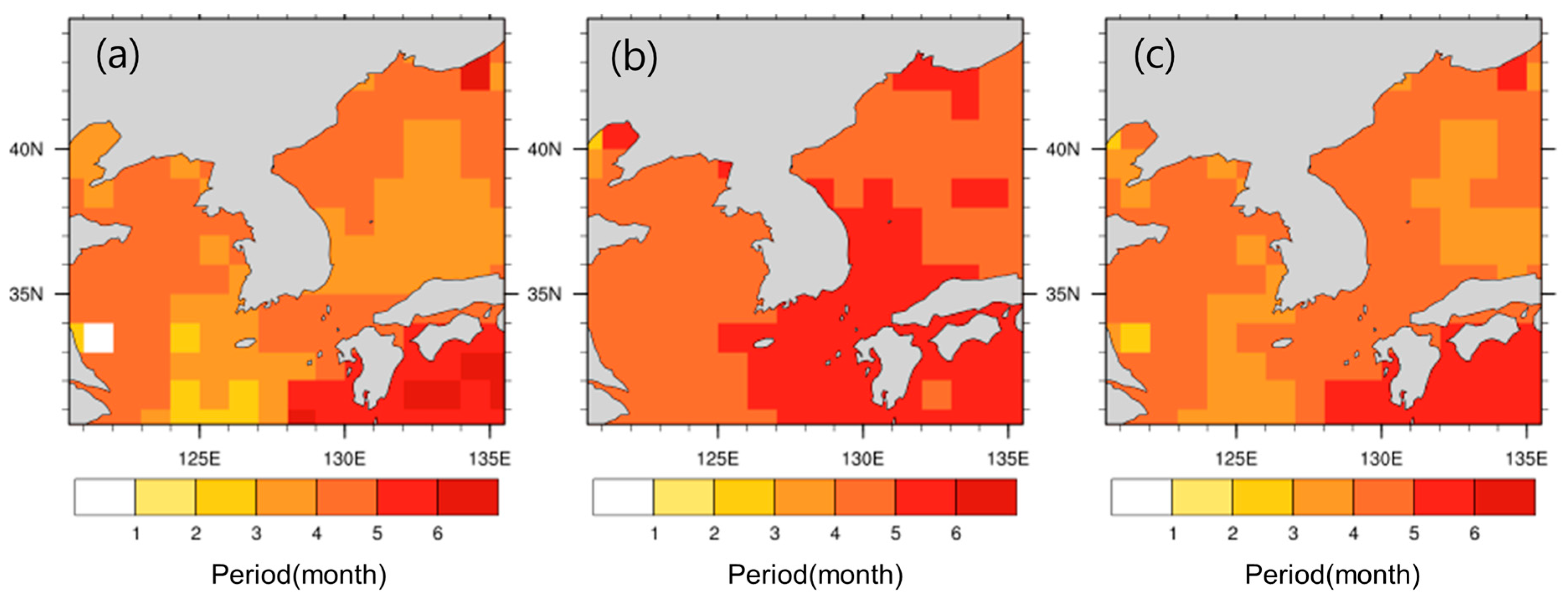
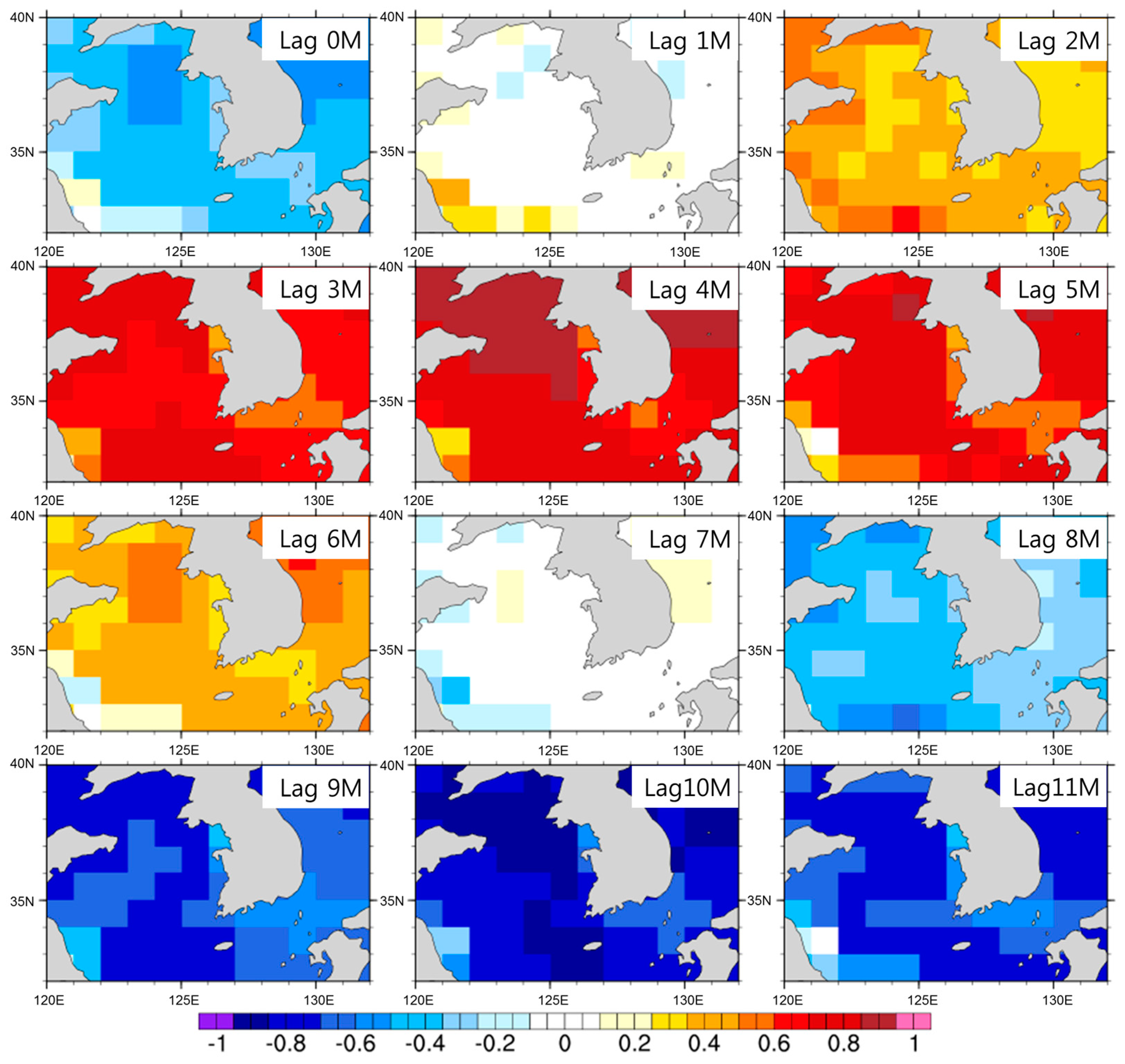
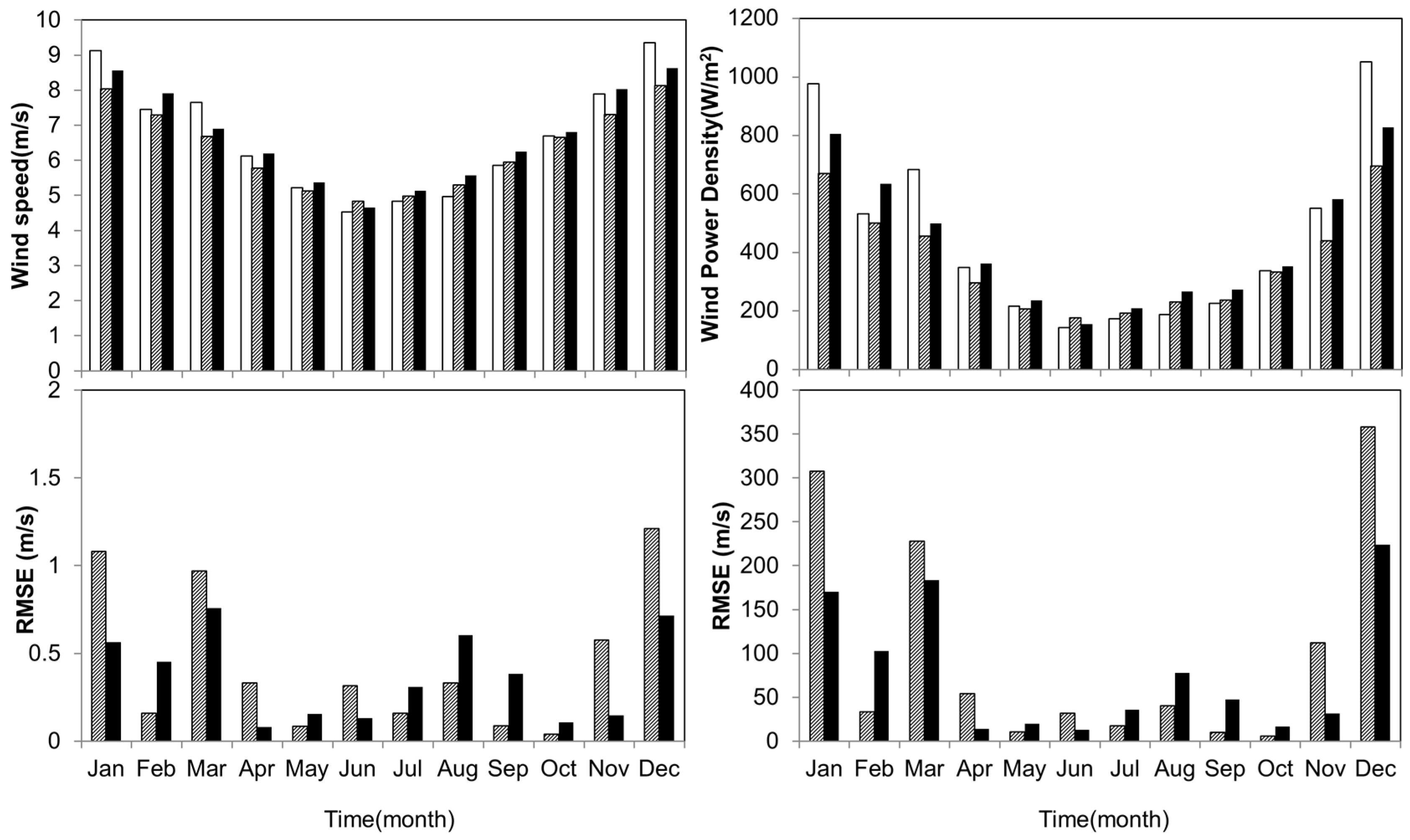

| Lag-Windows | End-Lag Time | |||||||||||||||
|---|---|---|---|---|---|---|---|---|---|---|---|---|---|---|---|---|
| Lag 2 M | Lag 3 M | Lag 4 M | Lag 5 M | Lag 6 M | ||||||||||||
| RMSE | CORR | SLOPE | RMSE | CORR | SLOPE | RMSE | CORR | SLOPE | RMSE | CORR | SLOPE | RMSE | CORR | SLOPE | ||
| Start-lag time | Lag 2 M | 2.34 | 0.47 | 0.71 | 1.84 | 0.75 | 1.21 | 1.13 | 0.81 | 0.95 | 0.89 | 0.86 | 0.85 | 0.69 | 0.86 | 0.87 |
| Lag 3 M | - | - | - | 1.89 | 0.71 | 1.10 | 1.65 | 0.82 | 1.28 | 1.09 | 0.82 | 0.93 | 0.75 | 0.84 | 0.83 | |
| Lag 4 M | - | - | - | - | - | - | 1.66 | 0.82 | 1.29 | 1.70 | 0.82 | 1.27 | 0.92 | 0.79 | 0.92 | |
| Lag 5 M | - | - | - | - | - | - | - | - | - | 1.83 | 0.75 | 1.19 | 1.50 | 0.77 | 1.23 | |
| Lag 6 M | - | - | - | - | - | - | - | - | - | - | - | - | 1.19 | 0.77 | 1.23 | |
© 2017 by the authors. Licensee MDPI, Basel, Switzerland. This article is an open access article distributed under the terms and conditions of the Creative Commons Attribution (CC BY) license (http://creativecommons.org/licenses/by/4.0/).
Share and Cite
Kim, J.-Y.; Kim, H.-G.; Kang, Y.-H. Offshore Wind Speed Forecasting: The Correlation between Satellite-Observed Monthly Sea Surface Temperature and Wind Speed over the Seas around the Korean Peninsula. Energies 2017, 10, 994. https://doi.org/10.3390/en10070994
Kim J-Y, Kim H-G, Kang Y-H. Offshore Wind Speed Forecasting: The Correlation between Satellite-Observed Monthly Sea Surface Temperature and Wind Speed over the Seas around the Korean Peninsula. Energies. 2017; 10(7):994. https://doi.org/10.3390/en10070994
Chicago/Turabian StyleKim, Jin-Young, Hyun-Goo Kim, and Yong-Heack Kang. 2017. "Offshore Wind Speed Forecasting: The Correlation between Satellite-Observed Monthly Sea Surface Temperature and Wind Speed over the Seas around the Korean Peninsula" Energies 10, no. 7: 994. https://doi.org/10.3390/en10070994
APA StyleKim, J.-Y., Kim, H.-G., & Kang, Y.-H. (2017). Offshore Wind Speed Forecasting: The Correlation between Satellite-Observed Monthly Sea Surface Temperature and Wind Speed over the Seas around the Korean Peninsula. Energies, 10(7), 994. https://doi.org/10.3390/en10070994







